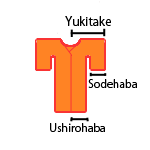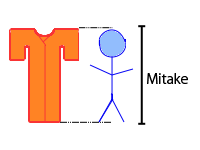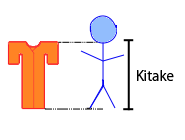Japanese Goods, flowing scents
from the traditional culture in Japan.
Pick up Items
Site Info
This is a free web app. Webアプリ
Add this button to your bookmark.
How to select a kimono
Choose your best fitting kimono
1. Size, a kimono's measurement
Unit: For Japanese traditional clothes, often old length units, Shyaku, are used. 1 Shyaku = 37.88cm. And sometimes Sun is also used. 1 Shyaku = 10 Sun.
Mearsurement Parts: You need to know two parts of lengths to fit kimonos on your body. The one is called Yukitake, the length from the bone rising on your back neck bottom to thorough your shoulder, elbow, and getting to the bone rising on your wrist. And the other one is called, Mitake(for ladies), the lengh equal to your body height.
When you wear a kimono, it looks better to hide your wirst a little by a kimono's sleeve. So Yukitake should be + 2~3cm to your actual scale. Also Mitake should be a little longer than your height, because you can fix the lengh within the Ohashory part, the margin of kimono wearing underneath an obi(Too short is no means to fix up). About Ohashori, please refer How to wear a kimono 2
If you would like to wear a kimono just for a gown simply by flinging on it on your shoulders, you don't need to measure your Mitake, but you need to scale your Kitake, the height from the ground to your bone rising on your back neck bottom.
Men should use the Kitake scale, because men don't need to make the Ohashory part.
To fit more precisly, scale Usirohaba, the length from the bone rising on your back neck bottom to your shoulder. And Sodehaba, the length from your shoulder, thorough your elbow, and getting to the bone rising on your wrist.
2. Fabrics
A fabric of a kimono is usually silk. It has beautiful well-designed dyeing and weaving. However you should ask laundries to wash it, so its care is a little bit difficult in abroad. If you purchase a kimono which you wear with frequency, it is recommend to get a low price kimono that is washable and used man-made fabrics like true silk.
For a summer-season kimono, hemp is used for it, however very expensive. There is also hemp-like fabrics of man-made one. Yukata fabric is usually made of cotton. It absorbs sweats well and cool. Please select fabrics fitting your country's climate. (FYI: Kimonos are separated to the three seasonal types, "Winter Type", "Spring&Autumn Type", and "Summer Type".)
3. Styles (Dress Code)
A kimono is separated to different styles by its dress code. You don't need to take it serious, however scaning through these classes will help you select your best fitting kimono. Uchikake is worn for a bridal dress, and one type of the most gorgeous kimonos. Furisode is worn by young women who have not been married yet. It has long sleeves and colorful and cute designs. When you go something formal places, Homongi is safe to clear a dress code. No age restriction. Womens who have been married wear Tomesode, a chic and calm black kimono. Yukata, which is origin in a robe in the Edo period, is worn in the summer.
About mens' Kinagashi style is a casual wear. At the formal place, Hakama is worn over a kimono. Samui or Jinbei is easy to wear at home (Recommend!).
4. Traditional Production Area
Atushi Ori: Very interesting, having the feeling of beautiful nature of Hokkaido.
Nanbu Shibori: Beautiful dyeing in Iwate.
Seigo Sendaibira: The most famous and established Hakama production area.
Benibana Zome: Soft red color dyeing from Benibana flower.
Yuki Tsumugi: A high quality kimono of silk pongee. The mild texture is very nice.
Edo Komon: Very tiny dots dyeing, made in Tokyo.
Arimatsu Narumi Shibori: Beautiful dyeing by using strings.
Nishijin Ori: A famouse weaving kimono in the world.
Kyo Yuzen: A dyeing with painting, very beautiful and varied designs, made in Kyoto.
Hakata Ori: A thick weaving mainly for a nice obi.
Oshima Tsumugi: A chic and excelsent dyeing by mud, made of silk pongee.
5. Shopping
Normally people in Japan purchase kimonos at a specialty shop for kimonos or the kimono coner of a department store. And young people start to buy kimonos at online stores.
From abroad, you can purchase kimonos from online stores. There are online stores selling kimonos only toward customers in abroad. Because of price and convenience, they sell used kimonos. Or you can use intermediate service agents for private imports, to purchase from online stores in Japan. If you are the first time to buy a kimono, we recommend to get a washable kimono, an easily wearing kimono, or a yukata. For men, Jinbei or Samui.


